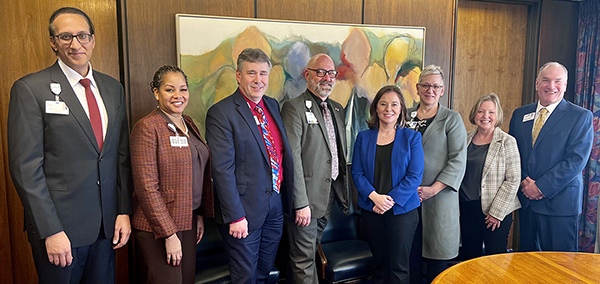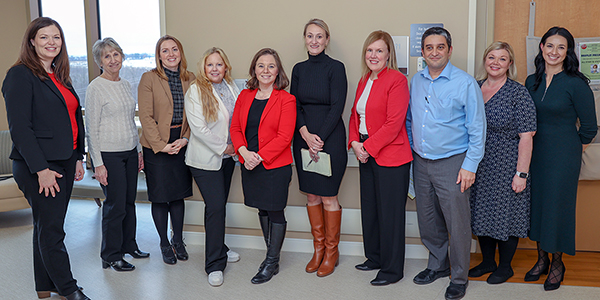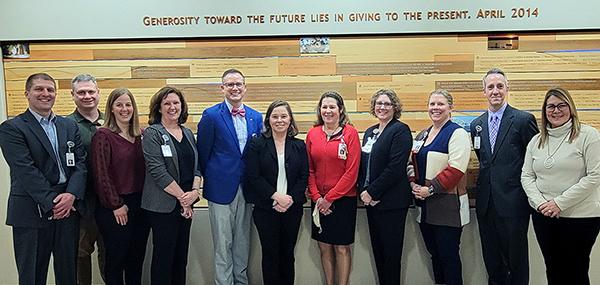Lieutenant Governor Sara Rodriguez, a registered nurse with master’s degrees in nursing and public health, will chair the State Task Force on Healthcare Workforce. Rodriguez traveled across the state the week of Jan. 29, 2024, meeting with hospital teams at Beloit Health System, Sauk Prairie Healthcare in Prairie du Sac, SSM St. Mary’s in Janesville and Froedtert Holy Family Memorial in Manitowoc.
 Lt. Gov. Rodriguez met with hospital leaders in Beloit. Pictured, left to right are Dr. Roger Kapoor, Nommo Donald, Jim Bird, Tom McCawley, Lt. Governor Sara Rodriguez; Sharon Cox; Ann Zenk, WHA; Tim McKevett, CEO, Beloit Health System.
Lt. Gov. Rodriguez met with hospital leaders in Beloit. Pictured, left to right are Dr. Roger Kapoor, Nommo Donald, Jim Bird, Tom McCawley, Lt. Governor Sara Rodriguez; Sharon Cox; Ann Zenk, WHA; Tim McKevett, CEO, Beloit Health System.
On Jan. 29 Evers signed
Executive Order #220 to create the Governor’s Task Force on the Healthcare Workforce, and named Rodriguez to lead the task force as chair. Hospital leaders welcomed the lieutenant governor for roundtable discussions of the workforce challenges they are facing, the solutions they are implementing and the partnerships they have made to not only grow the workforce faster, but to utilize the available workforce as efficiently as possible and protect their staff from burnout and burden, violence and threats in the health care workplace and increasing regulatory burden.
Discussions covered not just the most visible workforce pressures on hospitals and health systems and their workforce, such as sustained high vacancy rates and nursing shortages, but she also heard about factors straining the health care workforce like increasing time in electronic health records and meeting payer requirements that pull clinicians away from the bedside.
 SSM Health leaders met with state agency leaders about the Task Force on the Health Care Workforce. Pictured from left to right are State Rep. Jacobson, State Rep. Conley; Chelsea Hardacre, VP Patient Care, SSM Monroe Hospital; DWD Secretary Pechacek; Lt. Governor Rodriguez; Kayla Murphy, SSM St. Mary’s Janesville HR Director; DHS Secretary Johnson; Dr. John Russo, SSM St. Mary’s Janesville VP Medical Affairs; Elizabeth Waldoch, SSM St. Mary’s Med-Surg Director; and Haley Schreiber, SSM St. Mary’s Janesville ED and ICU Director.
SSM Health leaders met with state agency leaders about the Task Force on the Health Care Workforce. Pictured from left to right are State Rep. Jacobson, State Rep. Conley; Chelsea Hardacre, VP Patient Care, SSM Monroe Hospital; DWD Secretary Pechacek; Lt. Governor Rodriguez; Kayla Murphy, SSM St. Mary’s Janesville HR Director; DHS Secretary Johnson; Dr. John Russo, SSM St. Mary’s Janesville VP Medical Affairs; Elizabeth Waldoch, SSM St. Mary’s Med-Surg Director; and Haley Schreiber, SSM St. Mary’s Janesville ED and ICU Director.
Hospitals had an opportunity to share their pivotal role in providing clinical training opportunities for nurses and allied health professionals to help grow the workforce, the innovative programs they are implementing such as nurse internship and externship programs and the need to break down barriers to create greater flexibility and more options for individuals wishing to pursue health care careers.
 Lt. Gov. Sara Rodriguez toured Sauk Prairie Healthcare while she was there. Pictured, left to right, are Anthony Dix, Director Human Resources; Julus Pahl, Supervisor Acute Care; Colleen Neefe, Supervisor Human Resources; Monica Pilon, Director Primary Care; Dr. Nathan Grunewald, Urologist; Lt. Gov Sara Rodriguez; Lisa Pickarts, VP Patient Services; Belle Koch, Director Emergency Department; Kristen Quayle, Director Surgical Services; Shawn Lerch, CEO; and Chanda Kulow, Sauk Prairie School District Director of Curriculum and Instruction.
Lt. Gov. Sara Rodriguez toured Sauk Prairie Healthcare while she was there. Pictured, left to right, are Anthony Dix, Director Human Resources; Julus Pahl, Supervisor Acute Care; Colleen Neefe, Supervisor Human Resources; Monica Pilon, Director Primary Care; Dr. Nathan Grunewald, Urologist; Lt. Gov Sara Rodriguez; Lisa Pickarts, VP Patient Services; Belle Koch, Director Emergency Department; Kristen Quayle, Director Surgical Services; Shawn Lerch, CEO; and Chanda Kulow, Sauk Prairie School District Director of Curriculum and Instruction.
The lieutenant governor saw first-hand increased demand as she toured full inpatient units and busy emergency departments (ED). Staff members talked about bottlenecks waiting for post-acute care or behavioral health beds, and the ebbs and flows in census due to seasonal illness. At one visit, Rodriguez watched as physician and nurse leaders worked with ED, inpatient and surgical services teams work together to find care for all when inpatient census doubled in less than twenty-four hours, mid-week, when outpatient and surgical care was at peak level.
Workforce shortages and solving them are often local, but Lt. Gov. Rodriguez also learned there are many commonalities in the trends and barriers health care teams are facing, and statewide solutions can help. Health care leaders urged that the Task Force on the Healthcare Workforce should focus on improving reimbursement, supporting and enhancing programs like “Grow Our Own” grants, providing greater flexibility for new models of education, reducing regulatory burden, continuing to improve broadband access, and creating incentives to support technological advancement to grow and support the health care workforce needed to sustain the high-quality health care Wisconsin citizens have grown accustomed to and deserve.